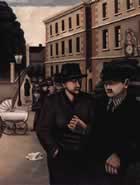Fembio Specials Famous Women from Hanover, Germany Grethe Jürgens
Fembio Special: Famous Women from Hanover, Germany
Grethe Jürgens

born on February 15, 1899 in Holzhausen near Osnabrück
died on May 8, 1981 in Hannover
German painter and graphic artist
Biography • Quotes • Literature & Sources
Biography


Grethe Jürgens studied painting in Hannover at the beginning of the Golden Twenties. In her circle of like-minded artists, she began to capture her impressions of student life and the petty bourgeois milieu in quickly dashed off sketches. The young artist was so impoverished that during her studies she lived in what she referred to as a “dog kennel”—before she moved in, her lodging housed purebred dogs.
She once commented on these early years: “We worked, we painted. We were often together. […] I am not a woman of the world, I did not travel much. We sat in Hannover and did not feel like we were 'innovators', only that we were different than the Expressionists, who belonged to a 'higher art movement'. […] We were simple, we had almost no money, but we were together and rode our bicycles out into the countryside.”
Grethe Jürgens was very close to her fellow student Gerta Overbeck, and it is often difficult to distinguish between their early works. However, after a friendship that lasted ten years their paths parted when Jürgens' companion began a relationship with Gerta Overbeck.
For financial reasons, until the end of the 1920s Jürgens worked as a commercial artist at the Hacketal Wire and Cable Works in Hannover. This was not exactly what a painter dreams of doing! It was during these years that she produced those paintings that would gain her notoriety: cool, realistic portraits of her fellow artists, stern depictions of the social environment and people from the “backyards of life”. Her most well known work is a contemporary document, Menschen vor dem Arbeitsamt (People at the unemployment office), painted in 1929.
Grethe Jürgens was closely involved with the dealings of Hannover's GEDOK section (GEDOK = Gemeinschaft Deutscher und Oesterreichischer Künstlerinnen und KunstfreundInnen (Association of German and Austrian women artists and friends of the arts)) from 1929 until well into old age. In the final years of her life she continued to be active as a member of its jury.
Her late work consists of graphic paintings that lean towards the abstract, in which however the figurative is never completely abandoned. New Objectivity was rediscovered in the 1960s. Together with Gerta Overbeck, Grethe Jürgens is considered to be its most distinguished representative.
Transl. Rebecca van Dyck
Author: Renate Rochner und Luise F. Pusch
Quotes
It appears to me to be a barbarian view of art not to consider it to be an obligation, but rather merely a means to greater comfort and greater pleasure. Art, a kind of intellectual whipped cream, is plopped onto the cultural pudding. Art is the coat one adorns and warms oneself with, or it is only a decorative splodge of color on the wall. In reality, one would gain much more if one could decide on a completely different view of art—namely taking an active part instead of only enjoying it. (Grethe Jürgens)
Literature & Sources
“Der stärkste Ausdruck unserer Tage”: Neue Sachlichkeit in Hannover. 9.12.2001 - 10.3.2002. Ausstellungskatalog. Hg. Christian Fuhrmeister. Hildesheim; Zürich; New York. Olms.
Grethe Jürgens und Gerta Overbeck. 1982. Arbeiten der zwanziger Jahre. Ausstellungskatalog Bonner Kunstverein.
Meskimmon, Marsha. 1999. “We Weren't Modern Enough: Women Artists and the Limits of German Modernism. Weimar and Now: German Cultural Criticism, 25. Berkeley, CA. University of California Press.
Müller-Pieper, Renate. 1991. “Grete Jürgens (1899-1981): Unbeirrbare Künstlerin und eigenständige Frau”, in: Hiltrud Schroeder. Hg. Sophie & Co.: Bedeutende Frauen Hannovers. Hannover. Fackelträger. S. 187-199.
Scholz, Heike. 1999. Am Rande des Blickfeldes: Grethe Jürgens – eine Künstlerin der zwanziger Jahre in Hannover. Dissertation, Marburg.
Seiler, Harald. 1976. Grete Jürgens. Göttingen. Musterschmidt.
This Fem-Biography was sponsored by the city of Hanover.
If you hold the rights to one or more of the images on this page and object to its/their appearance here, please contact Fembio.


